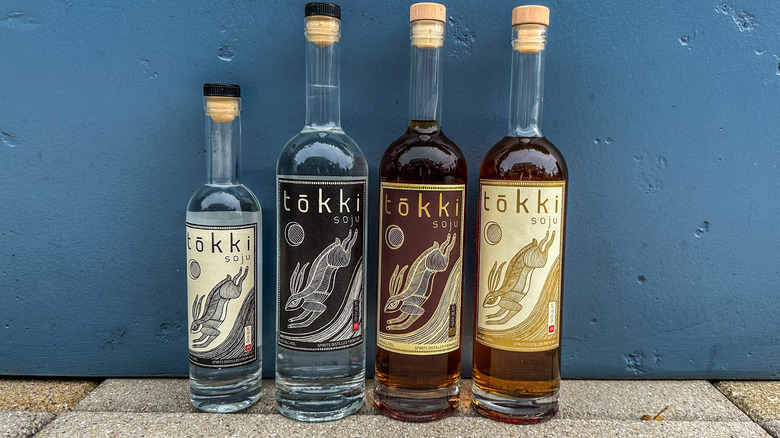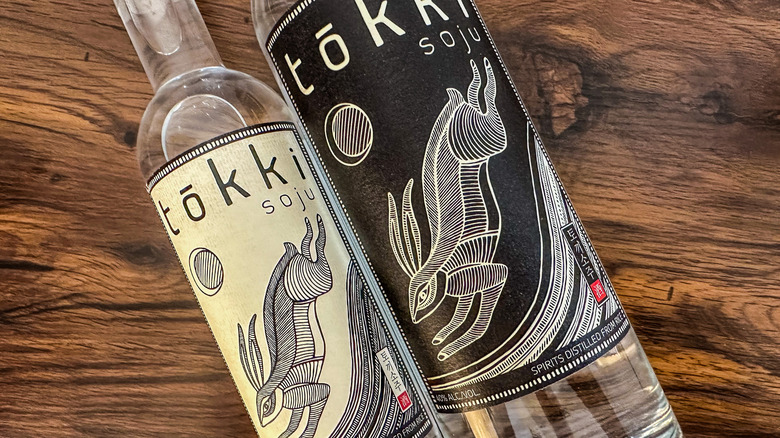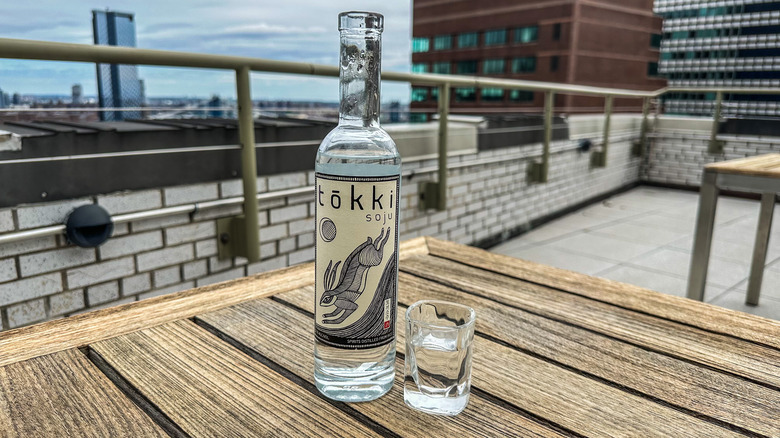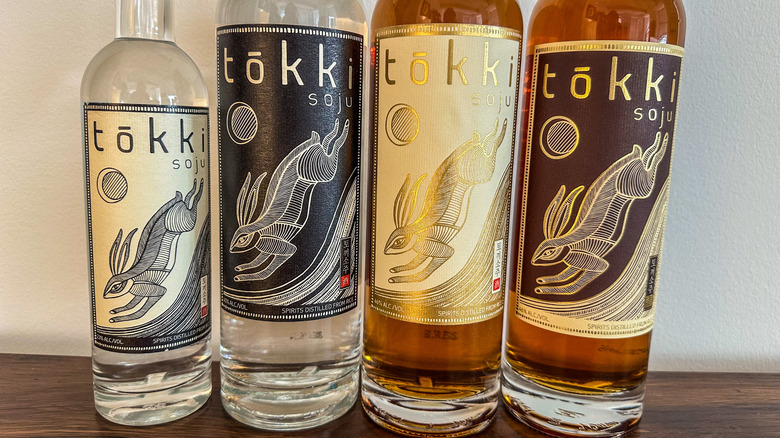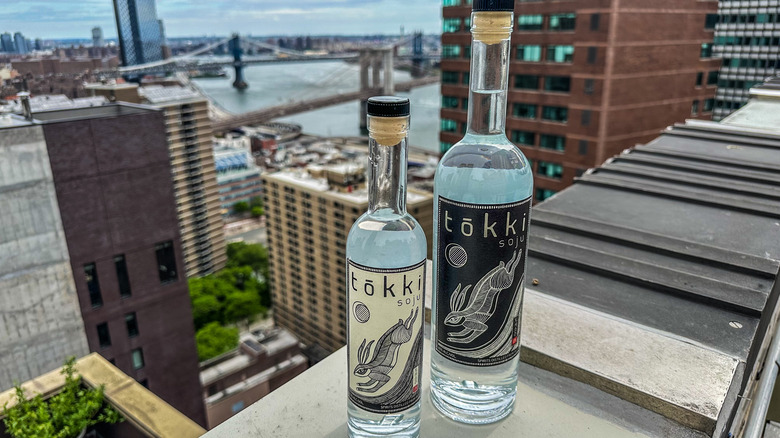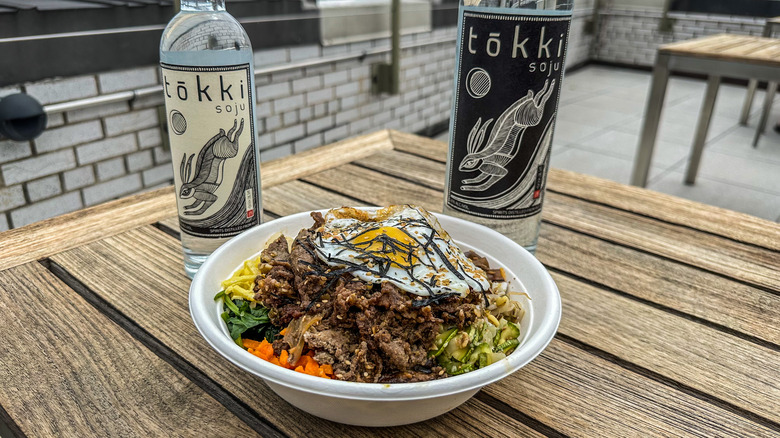Tōkki Soju: The Ultimate Bottle Guide
We may receive a commission on purchases made from links.
In the world of Korean soju, the green bottle has always reigned supreme. And while it may be the most recognizable, there is more, and better, out there. That's where Tōkki Soju comes in: founded in 2016, Tōkki (pronounced toe-key), is a New York City-born spirit, but has all the markings of a traditional Korean soju, from the ingredients and production to how it's best enjoyed.
A distilled spirit typically made from grains such as barley, rice, or wheat, soju is a spirit on the rise. According to a report from market research firm Datassential, soju is found on 0.9% of menus in the United States, which is up 31% over the last four years. While this may seem like small potatoes overall, brands like Tōkki are helping to bring soju to the mainstream, introducing a unique and flavorful spirit to the masses.
To learn a bit more about Tōkki, we spoke with the company's founder, Brandon Hill. We covered some of the history of soju, as well as what makes Tōkki a special and worthwhile spirit. In addition to tasting notes, we've got some information to help you determine if Tōkki deserves a spot on your home bar, or if you'll be ordering it next time it pops up on a cocktail or restaurant menu.
Some recommendations are based on first-hand impressions of promotional materials and products provided by the manufacturer and distributor.
What is Tōkki soju?
After spending time in Seoul in 2011 to complete a master's program, Tōkki founder Brandon Hill moved to New York, where he noticed an increased interest in Korean cuisine and a surge in Korean restaurants nationwide. At a time when only green bottle soju was available in the States and Korean restaurants struggled to pair food with it, Hill saw an opportunity to create something designed to tackle the conundrum: a traditional Korean soju, made locally and crafted with cuisine and cocktails in mind.
The name Tōkki, which means rabbit in Korean, comes from the year of the golden rabbit, 2011, the year Hill came to New York and found his calling. Tōkki Soju is available in four varietals: Black Label (40% ABV), White Label (23% ABV), Gold Label (46% ABV), and Garnet Label (46% ABV). Every bottle of Tōkki is made using the same traditional Korean style and techniques, starting with Korean glutinous rice called chap ssal. Second is quality water, followed by yeast and enzymes used in fermentation. Hill specifically uses nuruk, a saccharification enzyme unique to Korea, for Tōkki soju fermentation.
Soju production dates back to the 13th century
Korea has a long, rich history of making soju from rice, dating back to the 13th century. But it really starts with the name, which comes with its own set of complex origins. In the book "Soju: A Global History" by Hyunhee Park, Park goes into the origins of the name soju. In Korean, it uses the same Chinese characters as the Chinese liquor shaojiu, and is very similar to the characters used in shochu, a Japanese distilled liquor. According to Park, "The existence in East Asia of three variations of a traditional liquor of similar make, all bearing the same written name, suggests a shared origin in cross-cultural exchange."
Additionally, people in Korea, China, and Japan have frequently referred to soju as arak, a type of distilled alcohol common in the Middle East and Mediterranean. According to Park, exploring the origins of soju means traveling outside the confines of the Asian continent, as the production and technology used can be seen throughout Africa, Europe, and Asia at one time or another. While soju is inherently a Korean-made spirit, its story is far-reaching, showing how different cultures and societies benefited from sharing this "cultural object," as Park refers to it.
Tōkki is doing its own work to be a cross-cultural product by staying true to Korean production standards. And while soju is unique on the global stage, Tōkki seems designed to appeal to Western spirits standards as well.
Tōkki soju was born in Brooklyn
The rise in popularity of Korean cuisine happening around the time Hill moved to New York and after his time in Seoul is kismet. That craving, the desire New Yorkers had to embrace an unfamiliar and fascinating cuisine not commonly found in the U.S. drove Hill to start Tōkki. In Brooklyn, during the winter of 2016, Hill met with several Korean restaurant owners around New York City, and Tōkki was born.
As a true melting pot of a city, New York is open to embracing the food and drink of other cultures. With this curiosity and enthusiastic attitude for new and different flavors and culinary techniques, Tōkki found a comfortable home in Brooklyn. In late 2019, Hill and the Tōkki team moved operations from Brooklyn to South Korea, seeing an opportunity to return to roots as a Korean product while elevating the soju category on the world stage.
Still, the spirit of its Brooklyn founding remain. At Tōkki's first experiential space at RYSE, a boutique hotel in Seoul, the concept manifests as an ode to New York City and the people who have made Tōkki what it is today. The space embodies the look and feel of Brooklyn neighborhood cocktail bars as well as the feel of Tōkki as a spirit. The bar is complete with recycled pallets used to make the ceiling and a collection of spirits made in-house, including, of course, the soju.
What does Tōkki soju taste like?
It can be easy to write soju off as a spirit that looks and acts like sake or vodka — it is commonly referred to as Korean vodka after all. That may be true for a lot of the commercial soju on the market today, Tōkki isn't a standard commercial soju. It is meticulously handcrafted without any artificial sweeteners or flavoring agents, giving it a clean, fresh flavor that amplifies the taste of the rice without being overly sugary or synthetic tasting.
Starting with the White Label, the flavor is light and crisp, with notes of vanilla and lightly toasted nuts. The mouthfeel is light and a little creamy, with a smooth finish. Stepping up a few notches to the Black Label is when the flavor really starts to change. Laced with heavier notes of vanilla, nutmeg, and molasses, and with a richer mouthfeel, there's also a distinct fiery pepper note that comes in sharply and lingers for a while.
The Gold Label shows off barrel-aging with a deeply complex and unctuous flavor, rich with notes of caramel, butterscotch, dark chocolate, and gently charred oak. With the Garnet Label, which is aged in oak barrels and finished in sherry casks, flavors of dried cranberries and cherries, ripe peach, and toasted pecan combines for a smooth, full-bodied spirit.
How is Tōkki soju made?
With the production site in Chungju, South Korea, up and running, Tōkki decided to re-establish its U.S. presence in 2022 by opening up a production site in California. Through both distilleries, Tōkki produces approximately 700,000 liters of soju yearly. Currently, Tōkki is available in eight states in the U.S., including New York, New Jersey, Connecticut, Pennsylvania, Georgia, Louisiana, California, and Texas, and across several Asian-Pacific countries, including South Korea, China, Hong Kong, Taiwan, Singapore, The Philippines, and Australia.
The production process starts with glutinous rice, which is run through a hammer mill and then cooked in a mashtun on the same day, which helps the ingredients maintain their flavor and aroma. The cooked rice is then fermented in the traditional Korean style, using enzymes and yeast cultures, and distilled through a copper still filter to remove the sulfur compounds. After distillation, the soju is mixed with water. Then, it is bottled and labeled. For the Gold Label, the soju is aged in virgin oak barrels from the U.S. The Garnet Label expands on that process as it is finished in Pedro Ximenez sherry casks. To maintain its quality and authenticity, Tōkki does not add any chemicals, sugars, or flavoring agents to its soju.
How to drink Tōkki
Because each Tōkki soju varietal has a different ABV level, each one is designed to be enjoyed in its particular way. Starting with the White Label at 23% ABV, Brandon Hill recommends pairing it with food or simply drinking it neat from a shot glass, either slightly chilled or at room temperature. For food pairings, reach for more savory items, like a salty bar snack mix or a crisp and juicy Korean fried chicken, allowing the sweet and mellow flavor profile to tone down each rich and salty bite.
For a slightly higher ABV, Tōkki Soju Black Label can replace rum or vodka in classic cocktail favorites, such as a mojito or a classic vodka martini. At The Portrait Bar in the Flatiron neighborhood of Manhattan, Tōkki Black Label is used in a cocktail called the Mapo District, a Seoul-inspired cocktail. Made with Tōkki, sesame-oil washed Laphroaig, cucumber, lemon, and pineapple-vanilla cordial, the soju lends rich, full-bodied notes of vanilla and sweet rice pudding to balance the cocktail's smoky, nutty flavors.
Moving up to the barrel-aged varietals, Gold and Garnet, Hill suggests treating these more like a whiskey than a traditional soju. Enjoy them neat or with an ice cube like you would your go-to whiskey of choice. Or, mix them into a whiskey cocktail that highlights the spirit and its sweeter, more fruit-forward flavor characteristics, like a whiskey highball or a Manhattan.
Is Tōkki Soju expensive?
Each of Tōkki's soju four expressions range in price. The White Label, which has the lowest ABV of the collection at 23%, clocks in at about $30 for a 750 milliliter bottle. The next level up is the Black at 40% ABV, with a price tag of $40 for the 750 milliliter bottle. The Gold and Garnet are the most high-end of the collection, each at 46% ABV, each priced around $55 and $60, respectively. For someone soju curious but not quite ready to commit to a full handle, each bottle is also available in 375 milliliter bottles at a lower price point. Considering the $60 price point of the Garnet Label, which is the most high-end of the portfolio, opting for the full-sized bottle won't break the bank.
Compared to the more industrialized soju brands popular in the U.S., Tōkki is undoubtedly a higher end spirit with a price tag to match. That said, Tōkki is a craft spirit with a higher caliber of production and ingredient quality than these lower-end brands, giving the higher price point some validity. When you compare Tōkki's price tag to any other mid-range and high-end soju brand, the prices are about the same. For someone looking to find not just a quality soju, but one with a reasonable price tag, it is a bargain at twice the price.
Tōkki Soju vs. West 32 Soju
To get the best possible understanding of Tōkki Soju in the larger soju market, it's helpful to put it up against another soju made in New York City, West 32. Crafted without any chemical sweeteners or artificial additives, West 32 is available in two varieties: Original and Reserve.
Both West 32 options, similar to Tōkki's portfolio, are carbon filtered, however, the Original is bottled at 19.9% ABV, considerably lower than Tōkki White or Black Labels. The West 32 Reserve, like Tōkki Gold and Garnet, is barrel-aged, but again, bottled at a lower 32% ABV, as opposed to Gold and Garnet's 46%. Flavor in mind, West 32 has a more subtle, muted taste; Tōkki is far bolder.
Another noticeable difference between these two brands is the price point. The White Label Tōkki is approximately $30 a bottle, West 32 sits at a far lower price point at only $16. Similarly, the Reserve costs about $20, while the barrel-aged options from Tōkki go as high as $60.
Ultimately, the difference between these two brands comes down to how you drink them. West 32 is approachable and well-suited as a swap in for vodka-based cocktails or in the traditional Somaek cocktail, made with soju and beer. Tōkki, however, is a more sophisticated and versatile option, ideally meant to be enjoyed neat, but also as a savvy spirit upgrade in any number of classic cocktails.
This soju can be used in sweet and savory cooking
Whether your homemade creations are sweet or savory, soju is an absolute dream ingredient for any home chef. Because of its glutinous rice base, the lower ABV Tōkki soju has a rich, silky texture and a clean flavor profile, making it ideal for enhancing the flavor of any number of dishes.
Add your soju as you make the soy sauce marinade for the thinly sliced steak in beef bulgogi. This will give another layer of depth and creaminess to a sauce rich in umami and spice. For an upgraded vegetarian bibimbap, pour a small amount of soju in the gochujang sauce for some added body and biting complexity before you toss it with the rice and veggies.
Home bakers, soju is also about to have a special place in your heart. Its versatility in savory dishes is equally valuable for sweets and desserts, lending its silky texture and subtle sweetness to baked goods and refreshing cocktails. Yakgwa, a traditional Korean deep-fried cookie typically made during the Lunar New Year, uses soju in the base. Using a barrel aged soju like the Garnet Label is a perfect match to the cookie's finishing with honey ginger syrup. Soju is the star ingredient in a watermelon soju, along with fresh fruit, ice, and lime juice; its mild, neutral flavor makes it an easy swap in various vodka-based cocktails.
The enzymes used in Tōkki are unique to Korea
Fermentation is a crucial part of alcohol production; it's the process by which yeast is used to convert sugar into alcohol, turning your grape juice into a fine wine. The fermentation step is just one of the ways Tōkki is sticking to traditional Korean techniques for soju production by using nuruk, an enzyme unique to Korea, during its soju fermentation. According to Makgeolli Lab, nuruk is one of the most important elements of Korean alcohol production, especially when it comes to soju. The enzyme comes from mold and yeast that grows from crushed wheat.
Nuruk is a necessary ingredient in soju production, especially for Tōkki, but it's not the only. According to Makgeolli Lab, ipguk is another widely used enzyme used in soju production. Nuruk is the more traditional of the two but often is perceived as having less consistent of a result comparatively. Nuruk can be made from different grain sources, providing different flavor notes depending on how it's made, which helps Tōkki maintain its distinct fermentation profile.
The Tōkki distillery location is crucial to its quality
Located in the heart of the Korean peninsula, the Chungcheongbuk-do mountains are rich in history. Currently under consideration by UNESCO to be nominated as a world heritage site, the Chungcheongbuk-do area is home to 212 mountain fortress sites. This area is also home to the Tōkki distillery. According to UNESCO, these defense sites were built using the abundant, natural environment of the Korean peninsula to their advantage, and the natural world is what also gives Tōkki it's particular competitive edge.
Interestingly enough, Tōkki distillery has a farm license meaning all agricultural products it uses must be sourced from this region of the country. As the only landlocked state in South Korea, Chungcheongbuk-do is a mountainous region with rivers and basins that produces a large amount of grain. According to Brandon Hill, it is the quality of the region's rice and the water that makes this such a special and worthy location.
Hill notes that the water quality in this region has a good pH for soju, and few minerals to impact flavor, making it ideal for Tōkki's fermentation needs. It's also the only one of few region capable of producing the amount of chap-ssal rice that Tōkki needs for its production, meaning setting up shop in the province wasn't just good craft, it was crucial.

